Cremeschnitten (or Cremeschnitte) are Austrian cream slices comprised of crisp puff pastry sandwiched around a thick layer of vanilla custard. There are many similar sweets throughout the world, but these decadent pastries are the Austrian/Viennese version.
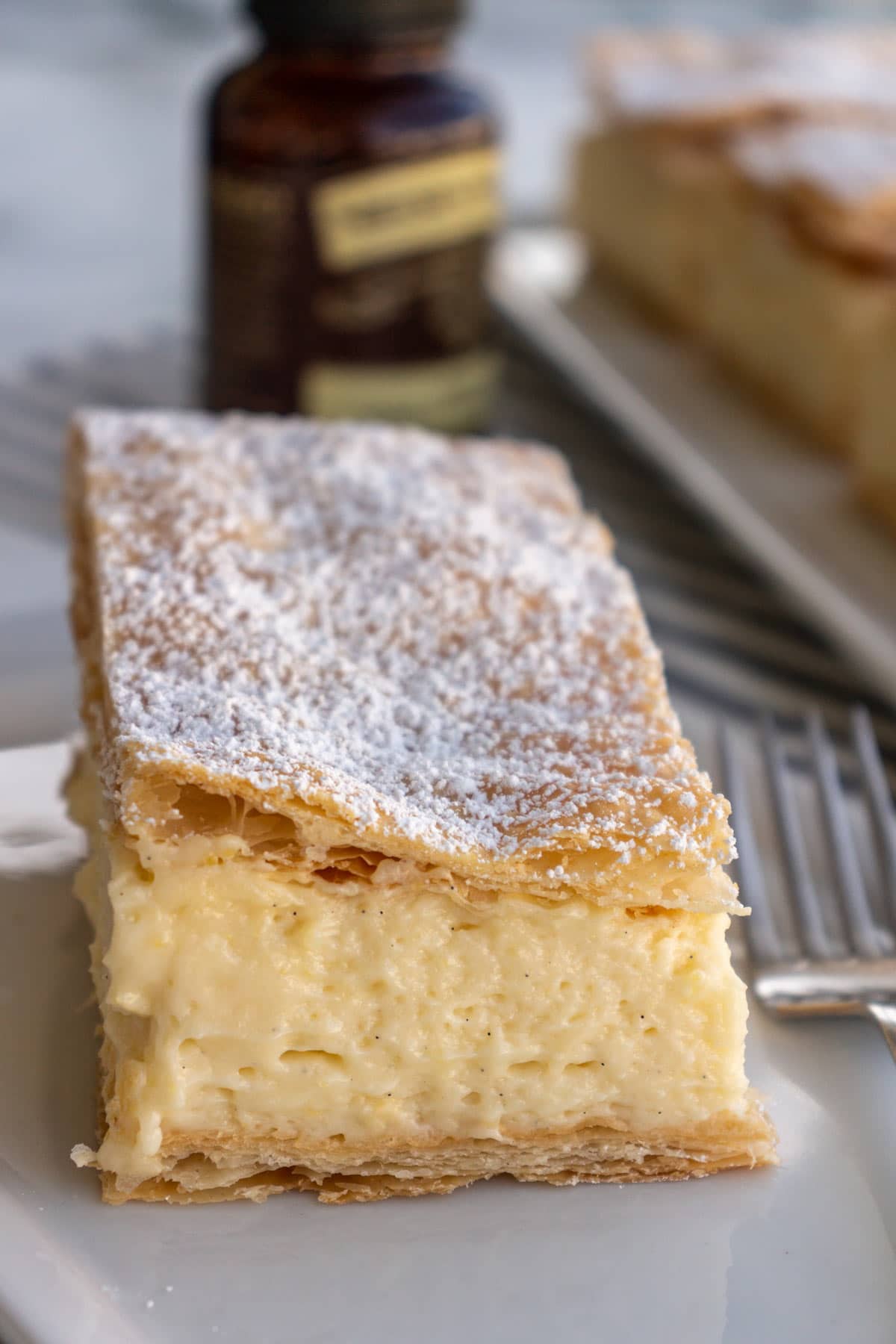
Cream slices go by many names and have many variations through the world. In their simplest form, they are sheets of baked puff pastry layered around and/or between pastry cream. Then they're cut into rectangles or squares, usually dependent on their origin. Here is a rundown of some varieties from around the world.
- Austria: Cremeschnitte (or cremeschnitten for plural) is simply 2 layers of puff pastry with a thick layer of custard in between, finished with powdered sugar. It sometimes uses gelatin and/or beaten egg whites/meringue to help set the custard. After setting in the fridge it's sliced into picture perfect rectangles, although you could opt for smaller squares if serving a crowd.
- France: Called mille-feuille (which means “thousand sheets”) and sometimes Napoleon pastries. They're typically made up of 3 layers of puff pastry alternating with 2 layers of pastry cream. The top is often finished with white and chocolate decorative glaze, pastry crumbs, or sometimes simply powdered sugar.
- United Kingdom and Australia: Often called vanilla slice, custard slice, or cream slice. It usually has 2 layers of puff pastry with a single thick layer of pastry cream in the center. In Australia they sometimes use gelatin to set the custard.
- Hungary: Hungarian krémes and are very similar to Austrian cremeschnitte. They can include gelatin and beaten egg whites to set the custard.
- Slovakia: Called krémeš. Similar to Austrian cremeschnitte and Hungarian krémes, but also have a thin layer of whipped cream between the custard and top layer of pastry.
- Russia: Napoleon cake is similar to the French Napoleon pastry but is in a cake form with many more layers of pastry and custard.
Ingredient notes
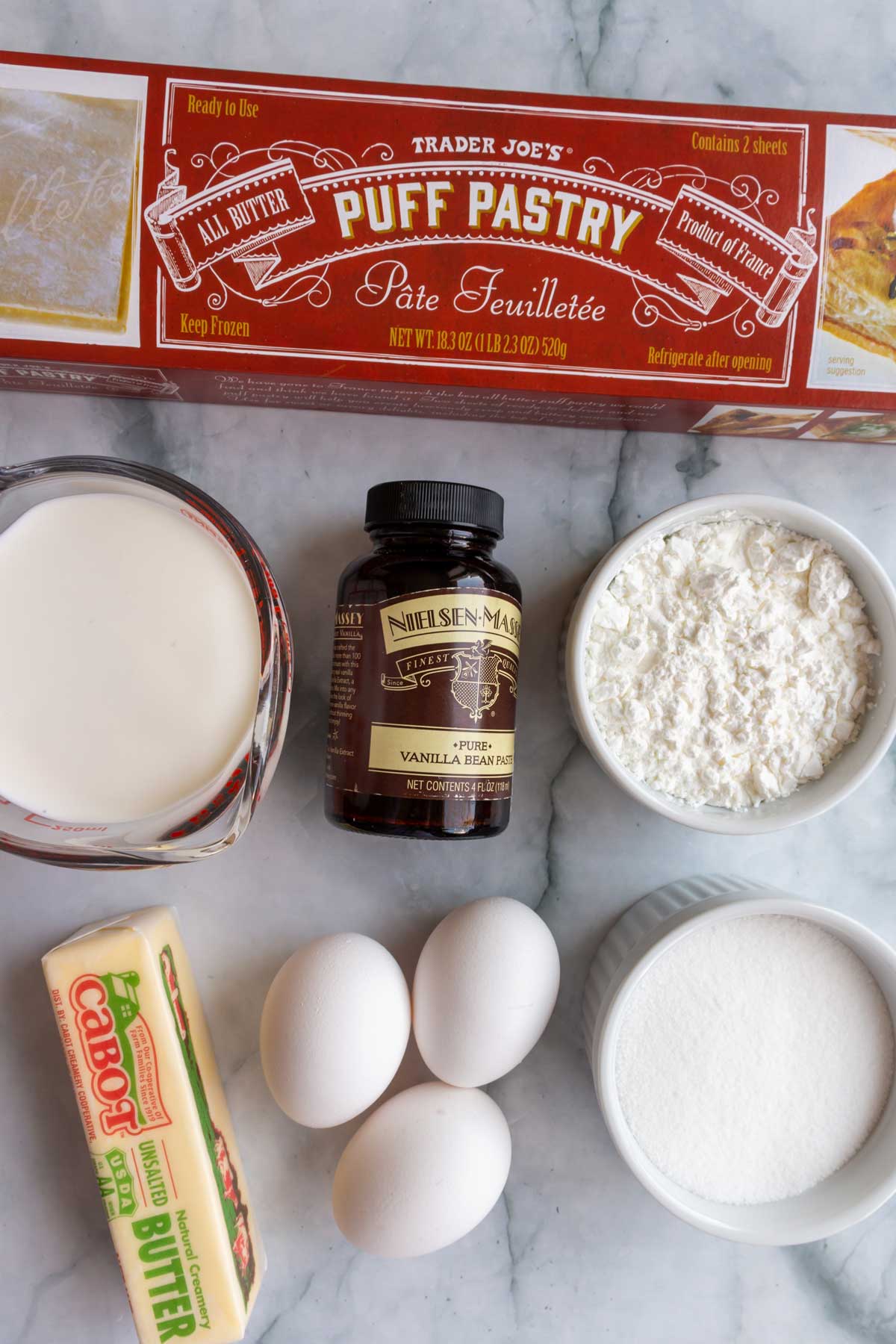
- Puff Pastry: There are many brands of puff pastry available on the market. Plan to use an all-butter puff pastry for optimal flavor (meaning it's made with butter and not shortening or other fats). My usual go-to brand is Trader Joe's. Their puff pastry sheets are about 9 ½ inches by 12 ½ inches each, but will shrink by about 1 inch in both directions after baking. The dimensions of different brands will vary, but this recipe will work regardless. Just plan to use a pan for assembly that will fit your baked pastry, or trim the pastry as necessary to fit.
- Milk: Over the years I have made pastry cream with all different types of milk, from low-fat to whole. Although whole milk is always your best bet, you can make this with whatever kind of milk you have on hand.
- Cornstarch: This cremeschnitte recipe uses a lot of cornstarch (corn flour). While some cream slice recipes also use a bit of gelatin to help set the custard, I want to avoid that because gelatin isn't vegetarian. This ample quantity of cornstarch does a fantastic job of setting the custard to optimal thickness, which in turn yields picture perfect cream slices.
- Vanilla: Use pure vanilla extract or vanilla bean paste to flavor the custard. I love vanilla bean paste because it's easy, convenient, lasts longer in the pantry than fresh vanilla beans, and you still get the gorgeous specks of real vanilla bean throughout your custard!
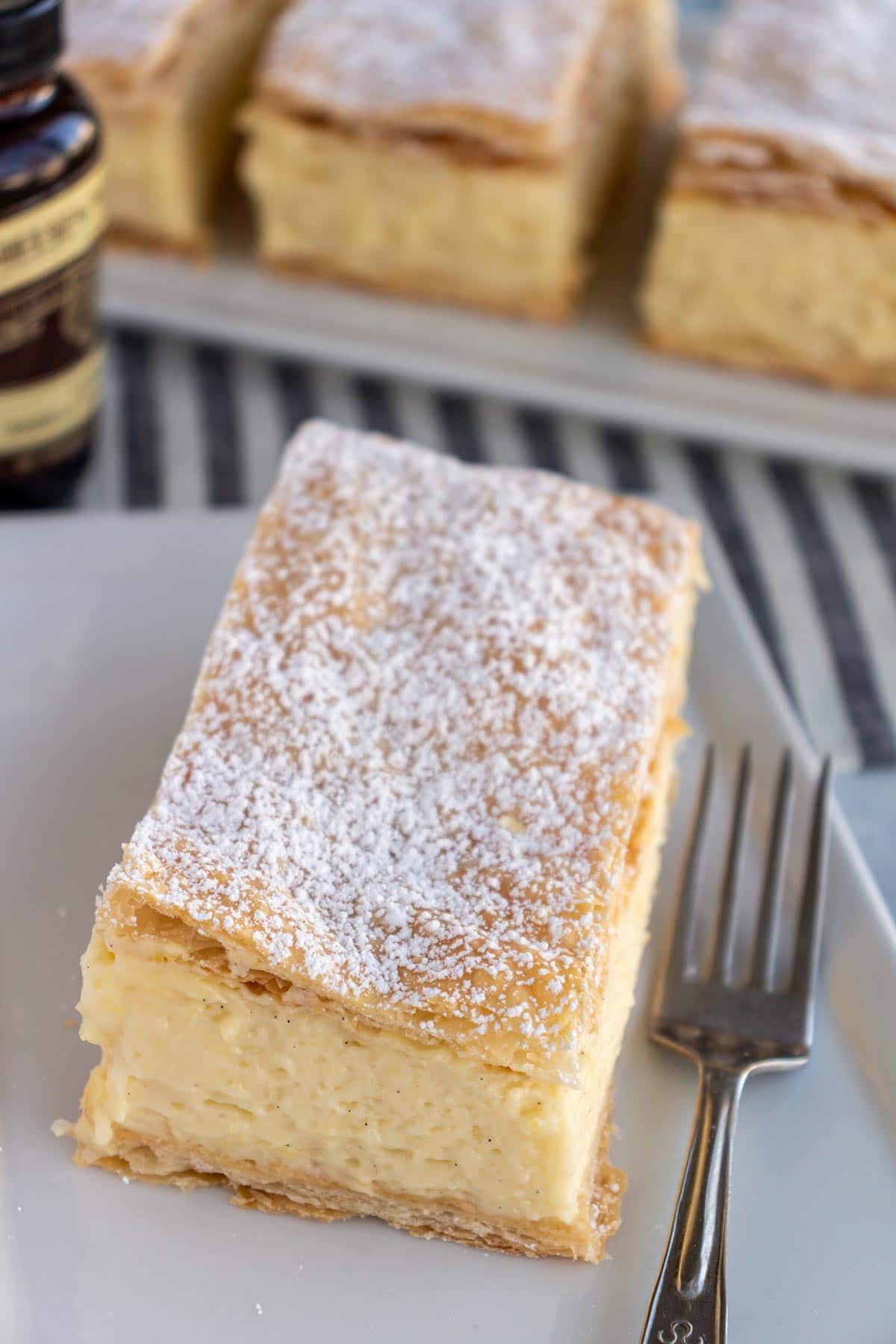
How to make it
Arrange puff pastry sheets on parchment paper lined baking sheets. Prick the tops of both sheets with the tines of a fork (PHOTO 1). Bake until golden brown and crisp, then set aside to cool (PHOTO 2). It will shrink a bit after baking.

Line the bottom and sides of a pan approximately the same size or slightly larger than your baked puff pastry rectangle with parchment paper. Make sure there is some overhang you can later use to lift out the cream slices. Place one cooled puff pastry sheet in the bottom.
Use a serrated knife to cut the other puff pastry sheet into 8 rectangles or 16 squares. Rectangles are a more traditional shape for cremeschnitte in Austria, but other countries with similar recipes sometimes make squares. Leave the cut rectangles/squares in the same arrangement and set aside.
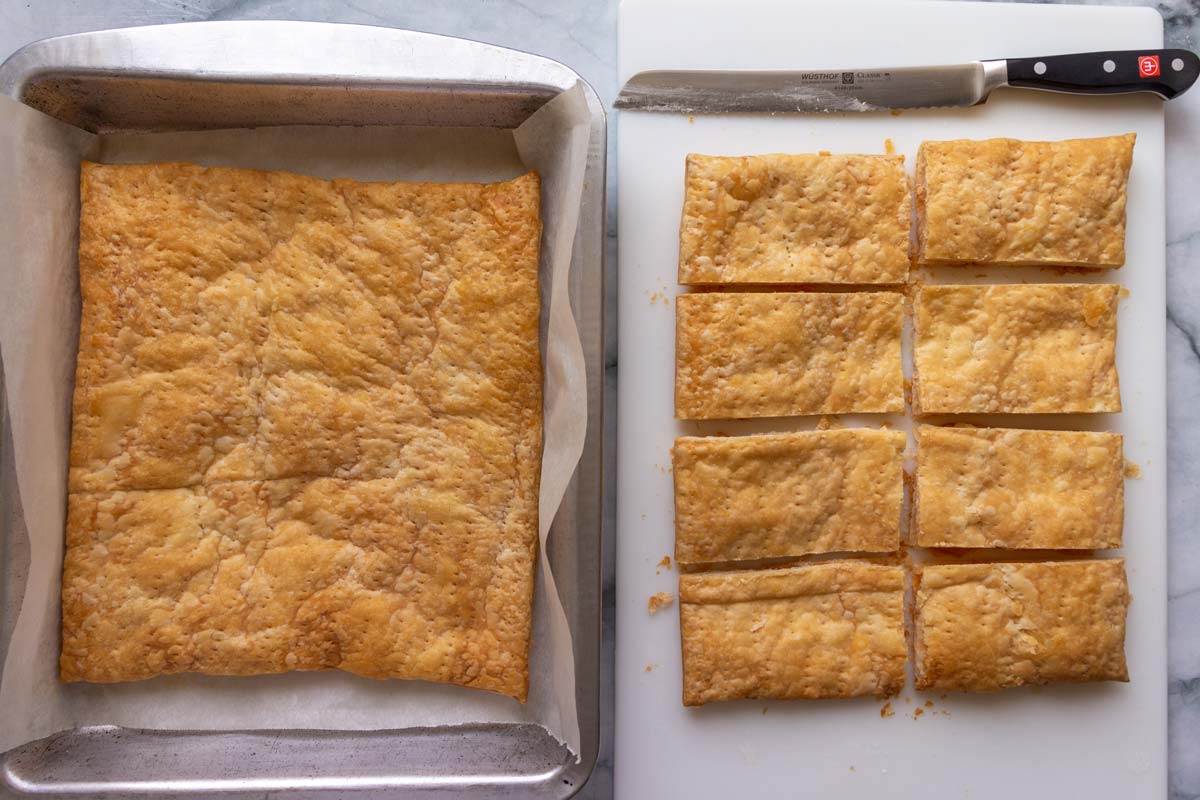
In the bowl of an electric mixer beat the egg whites until soft peaks form. Add sugar and continue beating until thick and shiny. Set aside.
In a large saucepan or small pot beat the egg yolks together, then slowly add the milk beating until smooth. Add the remaining sugar and cornstarch and whisk until smooth.
Heat the pan over medium heat, whisking constantly until the mixture is very thick and easily coats the back of a spoon. Remove from the heat, whisk in vanilla and butter until smooth, then use a rubber spatula to scrape the mixture into a medium mixing bowl.
In a couple additions, fold the meringue into the hot custard until no streaks remain (PHOTOS 3-4).
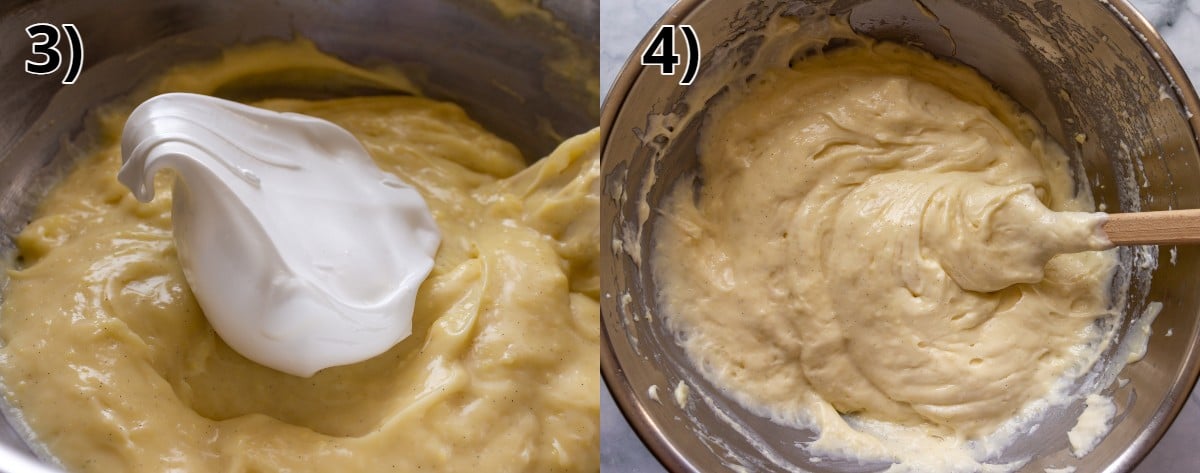
Pour the custard over the baked puff pastry set in the pan and smooth out the top. Arrange the cut pieces of baked puff pastry over the top (PHOTOS 5-6).

Chill the assembled cremeschnitte in the refrigerator for at least 2 to 3 hours to fully set.
Carefully lift the cremeschnitte out of the pan using the parchment paper overhang and transfer to a cutting board. The pre-cut top layer of pastry is a guide. Use a sharp knife to cut through the layers until the entire pan has been sliced into pieces. Carefully wipe off the blade between cuts for super clean slices.
Dust the top generously with powdered (confectioners’) sugar and serve.
Cremeschnitte is best the day it is made or at the most within 1 day of assembly. On subsequent days the pastry will begin to soften. Store leftover cream slices covered with foil in the refrigerator. Putting them in a plastic container will soften the pastry more rapidly.
Please scroll to the bottom of the post for the full recipe (in a printable recipe card) including ingredient amounts and detailed instructions.
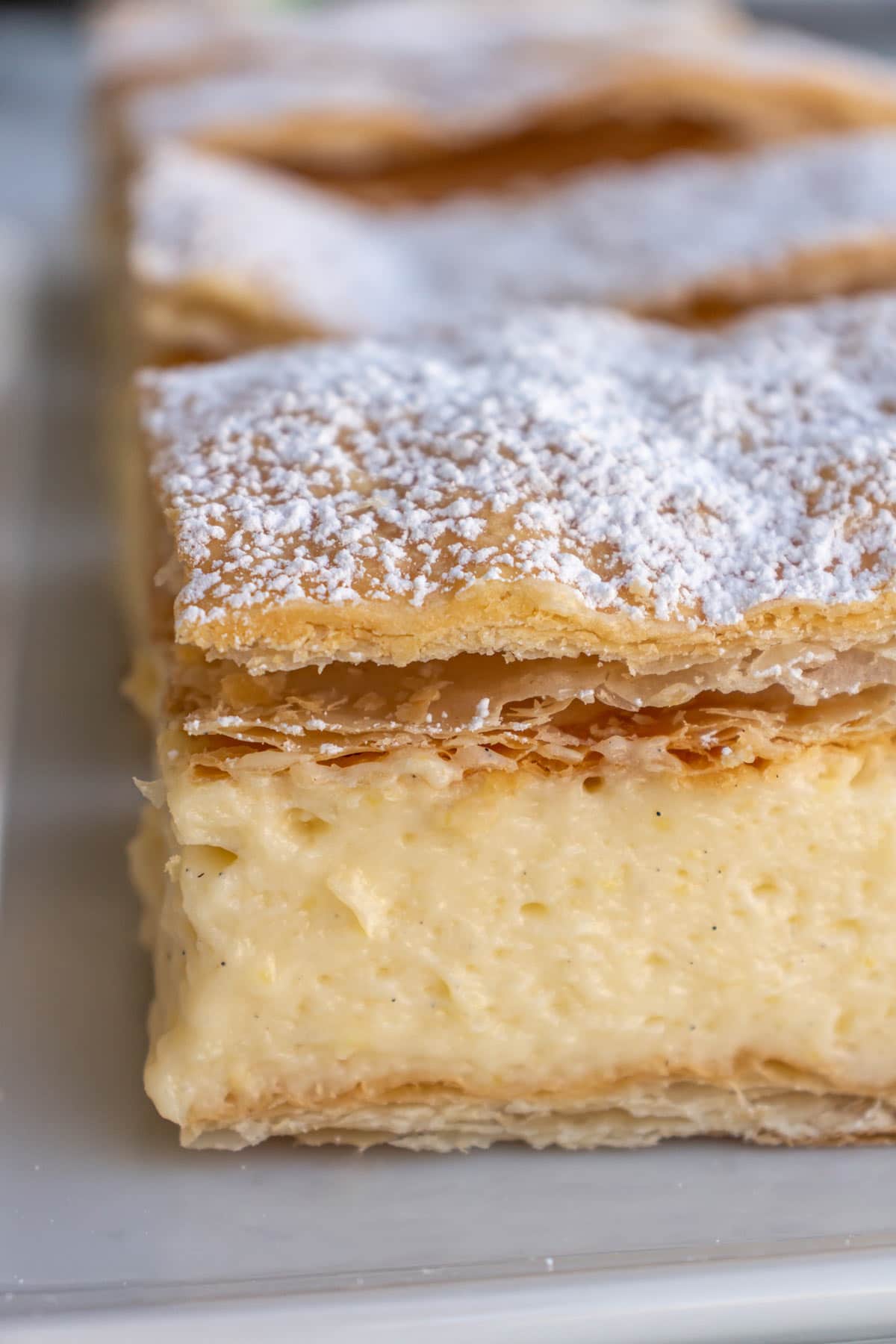
Expert tips
As the puff pastry bakes, if it puffs up too much or unevenly you can remedy this quite easily. Partway through baking, use a rubber spatula to carefully and gently press down on the overly inflated spots to help deflate a bit before returning to the oven. Make sure your bare hands aren't too close as the hot steam can burn you as it escapes from the pastry. Wear oven mitts! Do this within the first half of baking before the pastry fully sets and crisps.
Please note that the egg whites in this recipe are not fully cooked. Although the custard is hot, it doesn't actually cook the meringue by traditional standards. Take the same precautions you would if eating eggs with runny yolks, traditional French chocolate mousse, or blowtorched meringue on pie. All of these examples are considered undercooked eggs, and consumption of which may increase the risk of foodborne illness.
Normally when I make pastry cream I use a more classic technique. I beat together eggs, sugar, and cornstarch, heat the milk, whisk some into the eggs to temper them. Then I whisk the tempered eggs back into the milk to finish cooking. But in this recipe, there is a lot more cornstarch and a lot less eggs.
I have tested the recipe using the above technique and found it was crumbly and more difficult to yield a smooth custard. The technique I suggest instead works beautifully and yields a super smooth custard! Just be sure to whisk constantly, and if you end up with lumps or bits of egg you may sieve the mixture before using it.

Other recipes you may like
- Tompouce / Tompoes (Dutch Mille Feuille Pastry)
- Karpatka (Polish Carpathian Mountain Cake)
- Qatayef Asafiri / Atayef bil Ashta (Middle Eastern Cream Filled Pancakes)
- Vanillekipferl (Austrian Vanilla Crescent Cookies)
- Apfelstrudel (Austrian Apple Strudel)
- Topfenstrudel (Quark Strudel / Cheese Strudel)
- Buchteln (Austrian Stuffed Sweet Rolls)
- Donauwelle Kuchen (Danube Wave Cake / Snow White Cake)
- Boston Cream Pie Cupcakes
Tried this recipe? Please leave a star ⭐️⭐️⭐️⭐️⭐️ rating in the recipe card below and/or a review in the comments section further down the page. You can also follow me on social media on Facebook, Instagram, and Pinterest!

Cremeschnitte (Austrian Cream Slices)
Ingredients
- 16 to 18 ounces (2 sheets) puff pastry
- 3 large eggs separated
- 3 ⅓ cups (800 ml / 27 fl oz) milk
- 1 ¼ cups (250 grams / 8.5 ounces) granulated sugar (caster sugar)
- ⅔ cup (80 grams / 2.8 ounces) cornstarch (corn flour)
- 2 teaspoons vanilla bean paste or pure vanilla extract
- 3 tablespoons (40 grams / 1.5 ounces) unsalted butter cut into cubes
- Powdered (confectioners’ / icing) sugar as needed for dusting
Instructions
- Preheat the oven to 400°F/200°C. Arrange puff pastry sheets on parchment paper lined baking sheets (roll out to adjust dimensions if needed) and prick the tops of both sheets with the tines of a fork. Bake for about 20 to 25 minutes or until golden brown and crisp, switching pans from top to bottom and back to front about 15 minutes in. Set aside to cool.
- Line the bottom and sides of a pan approximately the same size or slightly larger than your baked puff pastry rectangle with parchment paper. Make sure there is some overhang you can later use to lift out the cream slices.
- Place one cooled puff pastry sheet in the bottom. Use a serrated knife to cut the other puff pastry sheet into 8 rectangles or 16 squares (or whatever works for the size/dimensions of your puff pastry sheets). Rectangles are a more traditional shape for cremeschnitte in Austria, but other countries with similar recipes sometimes make squares. Leave the cut rectangles/squares in the same arrangement and set aside. Pre-cutting them now will make it easier to portion your cream slices later.
- In the bowl of an electric mixer beat the egg whites until soft peaks form (they should be thick and foamy but not very stiff). Add ½ cup (100 grams / 3.2 ounces) sugar and continue beating until thick and shiny. It should hold a stiff peak and be glossy like meringue. Set aside.
- In a large saucepan or small pot, beat the egg yolks together, then slowly add the milk beating until smooth. Add the remaining ¾ cup (150 grams / 5.3 ounces) sugar and cornstarch and whisk until smooth.
- Heat the pan over medium heat, whisking constantly until the mixture is very thick and easily coats the back of a spoon and/or reaches a temperature of 180°F/80°C with an instant read thermometer, about 10 to 15 minutes total.
- Remove from the heat, whisk in vanilla and butter until smooth, then use a rubber spatula to scrape the mixture into a medium mixing bowl. In a couple additions, fold the meringue into the hot custard until no streaks remain.
- Pour the custard over the baked puff pastry set in the pan and smooth out the top. Arrange the cut pieces of baked puff pastry over the top. Chill the assembled cremeschnitte in the refrigerator for at least 2 to 3 hours to fully set.
- Carefully lift the cremeschnitte out of the pan using the parchment paper overhang and transfer to a cutting board (alternatively you can cut while it remains in the pan but I find it easier to do it this way). Using the pre-cut top layer of pastry as a guide, use a sharp knife to cut through the layers until the entire pan has been sliced into pieces. Carefully wipe off the blade between cuts for super clean slices. Dust the top generously with powdered (confectioners’) sugar and serve.
- This is best served the day it is made or at the most within 1 day of assembly. On subsequent days the pastry will begin to soften. Store leftover slices covered with foil in the refrigerator. Putting it in a plastic container will soften the pastry more rapidly.
Notes
- There are many brands of puff pastry available on the market. Plan to use an all-butter puff pastry for optimal flavor (meaning it's made with butter and not shortening or other fats). My usual go-to brand is Trader Joe's. Their puff pastry sheets are about 10 ½ inches by 12 ½ inches each, but will shrink by about 1 inch in both directions after baking. The dimensions of different brands will vary, but this recipe will work regardless. Just plan to use a pan for assembly that will fit your baked pastry, or trim the pastry as necessary to fit.
- For optimal convenience, use pure vanilla extract or vanilla bean paste to flavor the custard. I love vanilla bean paste because it's easy, lasts longer than fresh vanilla beans, and you still get the gorgeous specks of vanilla bean throughout your custard!
- Over the years I have made pastry cream with all different types of milk, from low-fat to whole. Although whole milk is always your best bet, you can make this with whatever kind of milk you have on hand.
- As the puff pastry bakes, if it puffs up too much or unevenly you can remedy this quite easily. Partway through baking, use a rubber spatula to carefully and gently press down on the overly inflated spots to help deflate a bit before returning to the oven. Make sure your hands aren't too close as the hot steam can burn you as it is released from the pastry. Do this within the first half of baking before the pastry fully sets and crisps.
- Please note that the egg whites in this recipe are not fully cooked. Although the custard is hot, it doesn't actually cook the meringue by traditional standards. Take the same precautions you would if eating eggs with runny yolks, traditional French chocolate mousse, or blowtorched meringue on pie. All of which are considered undercooked eggs, and consumption of which may increase the risk of foodborne illness.
Nutrition
*All nutritional information is based on third-party calculations and should be considered estimates. Actual nutritional content will vary with brands used, measuring methods, portion sizes and more.*

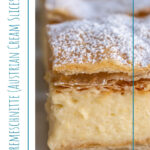


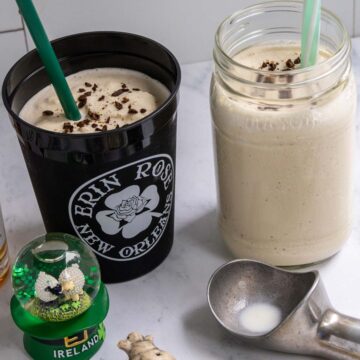
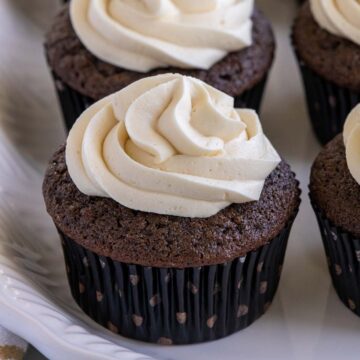


Kathleen says
You can’t provide any more clarity than “a pan?” There are no dimensions in Austria? Pans of expanding and extending sizes?
Victoria says
Hi Kathleen,
I actually do provide more clarity than just "a pan." The recipe says to arrange the baked puff pastry rectangle in "a pan approximately the same size or slightly larger than your baked puff pastry rectangle." Since people around the world would be using puff pastry of different brands which can yield different dimensions, the size pan is really dependent on the size that the puff pastry sheet bakes to. The actual size isn't as relevant as it would be for baking a cake for example since all you are doing at this point is assembling the cremeschnitte in the pan and it just kind of holds it all together while it sets. Just find a pan that is relatively close in size to the baked pastry and you should be all set. Even mine is not an exact match to the dimensions, but it's close enough to be able to assemble. I do mention in the post that the Trader Joe's brand of puff pastry sheets, which is what I use, are about 9 ½ inches by 12 ½ inches each, but will shrink by about 1 inch in both directions after baking, so that could also give you a rough idea of the size pan you may want to use. Good luck.
Herb says
The puff pastry I used puffed up higher than expected. The cream did not solidify when I followed the instructions and poured the cream over the bottom layer. Since I had extra cream left over, I stored it in a container and that solidified nicely. Instead of the soggy mess I ended up with, next time I will assemble the pastry after the cream has solidified. I also cut the top pastry into squares before baking. This was a much neater process.
Other recipes I researched also used gelatin but this cream recipe was outstanding.
Victoria says
Hi Herb,
I'm glad you enjoyed the recipe! I provide a little tip in the post and the recipe card notes for the puff pastry if it puffs up too high in spots--gently pressing it back down partway through baking to deflate it. That will definitely help for next time.
The custard does contain quite a lot of cornstarch so if you measure everything accurately (preferably by weight) and then cook it long enough if should thicken up significantly as you see in my step-by-step photos. I'm just curious if you used visual queues, the suggested cooking time, or an instant read thermometer to determine it was ready (this may be helpful for other readers too!). It's also possible that your egg whites weren't stiff enough before folding into the custard, and that caused the custard to thin out. Just trying to troubleshoot here.
All that being said, I'm glad your solution of chilling the custard before assembling worked for you! You could certainly do it that way if you prefer. At the end of the day, it's just about getting the cream in between the puff pastry layers because it will taste the same however you choose to assemble it 🙂
Stephanie J Lachtman says
Tastes fantastic but my custard didn't set up firm afterwards. Refrigerated it for 4hours. What could be the problem?
Victoria says
Hi Stephanie,
I'm glad you enjoyed the cremeschnitte but I'm sorry the custard didn't set up for you. This recipe uses a lot of cornstarch and the custard typically thickens significantly over the heat, even before cooling it. Did you make any modifications to the recipe, like using an alternative thickener? Did you weigh your ingredients or measure them with cups? It's possible you simply didn't cook the custard long enough but I can't be sure without more information.
Rene says
I made this last night, both my sister and I tried them this morning. omg I was so impressed tasted exactly like the ones I buy and love. A 100 percent amazing recipe. Perfect instructions and visuals. Easy and that's what I loved. Thank you for sharing!!! Will definitely make again. ❤❤❤ Kudos to you!!
Camilla says
Ok. So I’ve gotta wait forever to actually try these, (2-3hrs) but the filling is perfection. Can’t wait to try them once they’re set up! Great, easy to follow instructions.
This is my favourite dessert that I used to get all the time from an Italian bakery on Commercial Ave. In Vancouver, BC.
Beyond excited that I can make my own at home. The filling tastes just like I remember.